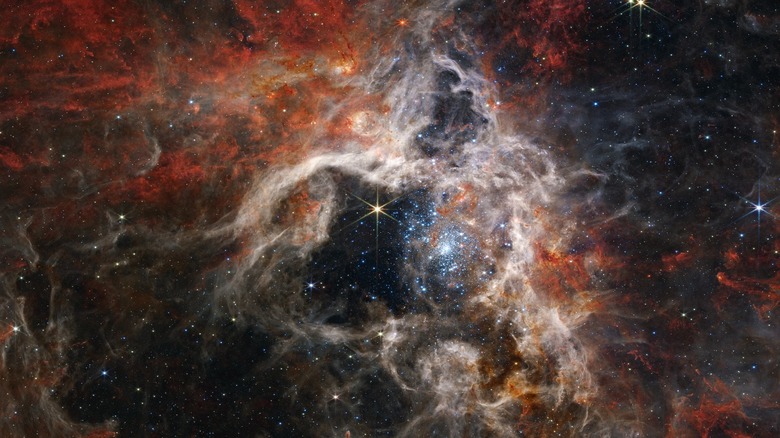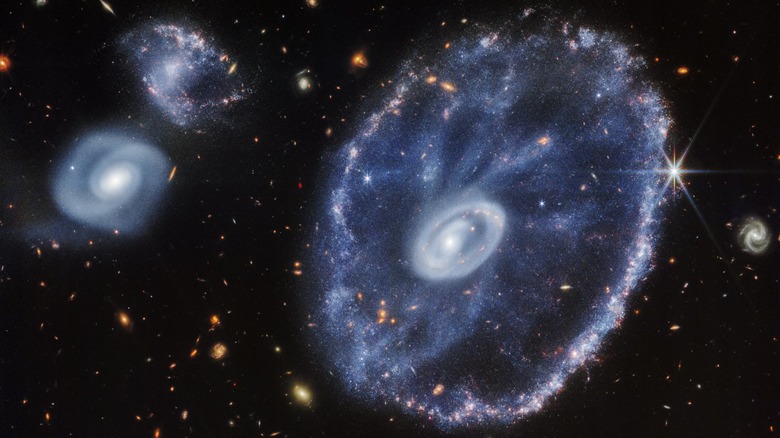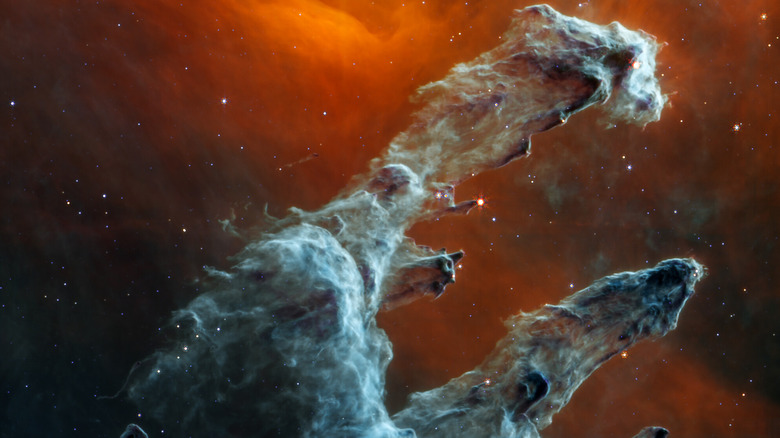The Universe Is Made Up Of Much More Dark Matter Than You Might Think
Everything we learn about the cosmos only makes it clearer how much we still have to learn. It's a testament to humility that science is flexible to update its conclusions, and bit by bit bring our understanding into a clearer light. Take dark energy and dark matter, two parts of a push-and-pull phenomenon that keeps individual galaxies stuck together, while the space between those galaxies continues to expand. Like plastic galaxy-balls floating in the water of an ever-filling space-sink, one day the light from those balls will be so far away, and the water filling so fast, that no ball will ever see another ever again. Even today, as Forbes says, "98.6% of the galaxies that we will ever observe are already gone" from the night sky forever.
By this explanation alone, you can see why dark energy and dark matter are so crucial to understanding the universe — they're the very conditions that allow us to gaze outwards from Earth. And, we've only known they exist for about a hundred years, as Discover Magazine explains. They're part and parcel of the "standard model of cosmology," and go far in explaining how our universe inflated in its early, post-Big Bang days, onward to its likely eternally lightless and lifeless end 1038 to 10100 years from now, as the University of Michigan reports. But as it turns out, most of the matter that'll be around to witness the future isn't stuff like us; it's dark matter. About 85% of it, in fact.
A normally abnormal universe
Looking at the things around you — maybe a chair, coffee cup, or phone — you might be mistaken for thinking there's plenty of such matter in the universe. We're talking about matter in the molecular sense — protons, neutrons, electrons, and all that. But as NASA tells us, this type of "normal" matter only makes up 5% of the cosmos. That's it. All of everything that exists that we can see, from stars to dogs, genes to pizza, is made of this type of matter. Such matter is called "baryonic" because it's composed of baryons, a kind of subatomic particle that can be hit with light. That's one way we know stuff is there.
So how about dark matter? We call it "dark" because we can't see it — it doesn't interact with or emit light. It has mass like regular matter, though. Otherwise, there wouldn't be enough normal matter in galaxies to generate the gravity that keeps galaxies together, as Live Science says. Dark matter comprises about 27% of the cosmos, which equals about 85% of all matter.
And the rest of the cosmos? We've got space dust, magnetic fields, neutrinos, cosmic rays, and so on, per NASA. Space isn't really empty; it's just full of thinly spread stuff. But without such matter — both dark and normal — we're still left with 68% of everything. That's how much of the cosmos is dark energy, the mysterious something that's fueling the expansion of the universe.
The dark mystery darkens
How do we know all this, exactly? Live Science cites cosmologist Joel Primack, who says some of our conclusions come from earlier stages of the universe's development. Using computer models, we know that galaxies today are distributed in clusters that reflect the distribution of matter in the cosmos' earliest days. Normal matter isn't enough to produce these clusters, however. There had to have been "pools" of dark matter present even from the beginning. That dark matter is still with us today, unseen and immeasurable by direct means.
Originally, as NASA's StarChild site reports, dark matter was called "missing matter" because it seemed like there was way too much mass in the universe for the amount of matter astronomers observed. Researchers had to look to indirect means to discover and measure it. For instance, a 1997 Hubble Telescope image showed light from a distant galaxy cluster bending around some invisible object. The invisible object needed a mass 250 times greater than what was seen in the image. NASA currently postulates that all galaxies formed within immense "halos" of dark matter.
That being said, the dark matter mystery deepens. Some galaxies, like AGC 114905, located 250 million lightyears from Earth, seem to contain no dark matter whatsoever, as Space.com reports. AGC 114905 isn't the first galaxy of its kind, though. Six galaxies total have been discovered containing zero dark matter. In the end, this means we might have to adjust dark matter's current figure of 85%.


